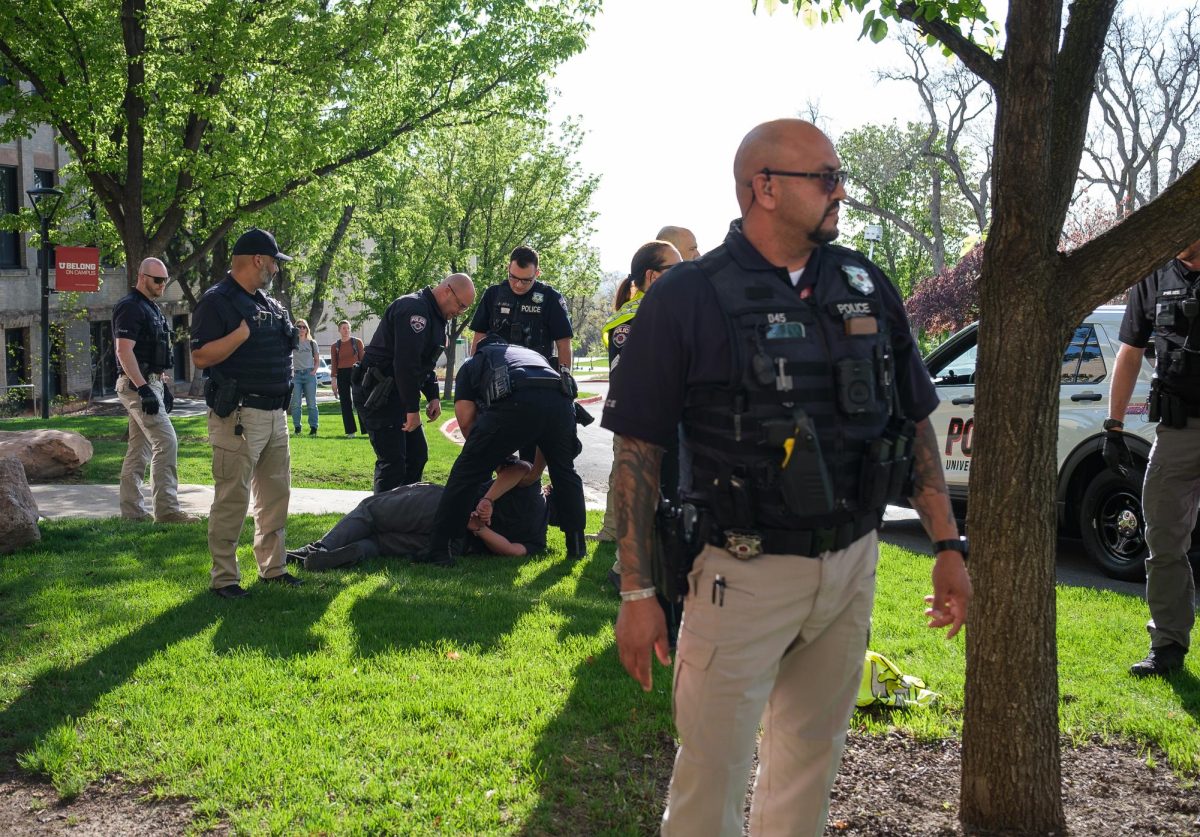As the snow melts and the salt clears off walkways, U students break out their longboards and transfer their carving skills from ski slopes to the sidewalks and streets of campus.
Wes Morin, a senior in film studies, is one of many longboarders who, in addition to weaving around his pedestrian peers on campus during the day, enjoys riding through campus at night when sidewalks are less congested.
“It’s pretty much just going up in the mountains snowboarding, except for it’s on pavement,” Morin said.
Night riding on campus is a growing trend among longboarders who ride for fun as well as transportation between classes.
Riders park their cars anywhere between Rice-Eccles Stadium and the Salt Lake City Public Library on 400 South and ride TRAX up to the Medical Center stop. They wind their ways down through parking structures and over the Legacy Bridge, weaving through streets and sidewalks until reaching a stopping point.
Some stop at the stadium and others weave through downtown sidewalks and streets braving cars and stoplights. Then they catch the next TRAX train up and do it all over again.
Boarders aren’t allowed to ride along city streets or sidewalks, except on the lanes specifically designated for cyclists, said Andrew Cluff, a recruiting officer for the Salt Lake City Police Department. Violators can be issued tickets.
Longboarding on campus gives riders a little more freedom, though it is still dangerous.
“They can ride like anybody else, like skateboards or bikes on the interior campus, but the problem is when they get out in the middle of the road, especially like in the middle of the night,” said Sgt. Arb Nordgran of the U Police Department. “When they get out in the middle of the road and they weave back and forth in the middle of the lanes, that’s where the problem occurs.”
Nordgran said it’s dangerous for longboarders to be in the street at night because of reduced visibility for drivers, and longboarders don’t always see or hear approaching cars.
But it’s a rule U Police have a hard time enforcing.
“By the time someone calls in a complaint, by the time the police get to that location, they’re
gone,” Nordgran said. “It’s not safe.”
And longboarding on campus isn’t just for U students.
Spencer Hankins, a junior in electrical engineering at Salt Lake Community College, said he and his friends like riding on the U campus because of the slopes and clear walkways.
“I have the longboard in the back of my car all the time, so if there’s like a big long steep hill that I want to try, I’ll just stop my car and…drive down the bottom, and I get to try and go down it,” he said. “Sometimes it has good results, sometimes not so good.”
Whether in the middle of the street at night or in a parking lot during the day, longboarding is always a high-risk activity. There are no laws about wearing a helmet, though some wear helmets and gloves. Longboarders sustain all kinds of injuries, the most frequent being road rash, but shattered bones aren’t uncommon, said Morin, who fractured his wrist while longboarding.
Chad Talbot, a business student at Salt Lake Community College, has a lump on his forearm that resembles a second elbow, which he got from longboarding on the U’s campus.
The longboard, unlike its shorter and lighter cousin the skateboard, isn’t used for tricks or stunts, but mainly for transportation and cruising. Riders get their thrills from making wide, sweeping turns at high speeds.
For many boarders, going down the Legacy Bridge is especially popular, though tricky. Boarders have to stop quickly without much room before hitting the stairs, but that’s why Ryan Leonard likes it.
“Knowing that there’s a chance you’ll fall and get really hurt is fun,” said Leonard, a sophomore in mass communication. Leonard has been longboarding for more than four years and estimated he can ride all around lower campus in about seven minutes.
He and a group of friends ride through campus at night when weather permits and between classes during the day. Leonard said it’s a great way to get around and he doesn’t mind weaving around walking students.
However, not all students are fond of longboarders. Many don’t know what to do when they hear the grinding of wheels on the sidewalk coming up behind them.
“I sometimes try and get off the sidewalk,” said Kimberly Stoker, a junior in speech pathology. But many longboarders say that’s not always the best thing to do.
“When people try and get out of the way, that’s when they get hit,” Morin said. “If they’re just kind of walking, doing their own thing, it’s much easier for you to get around them.”
 Erik Daentiz
Erik DaentizThomas Ziehweg and Ryan Leonard ride their longboards across Legacy Bridge. Swaney and Leonard are among a large number of students and non-students who ride their longboards down the hills on campus.
 Erik Daenitz
Erik DaenitzRyan Leonard and Thomas Ziehweg ride the TRAX train to the top of campus then they ride their long boards back down.
















